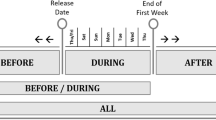Abstract
Critics and their opinions or critical reviews play a major role in many markets. Marketing research on how critics impact product performance has so far examined an aggregate critic effect. An obstacle in studies examining the relationship of aggregate critical opinion and product sales is the close association between the intrinsic quality of a product and the aggregate opinion regarding the product. Our analysis parses out these two effects, allowing us to distinguish individual critics who are simply good at identifying products with popular appeal from those who act as opinion leaders and engender early product sales. The role of critics is especially prominent in the film business, in which one finds multiple expert opinions about each movie and where critics’ endorsements are used in advertising. In the context of the motion picture industry, our research investigates the impact of individual film critics on the market performance of movies, where specific key critics and reviewers may serve as market gatekeepers, and where various critics may have different types of impacts on product performance.


Similar content being viewed by others
Notes
Although Eq. 1 allows for negative sales, constraints on the space of estimated parameters (e.g. that market potential m i must exceed cumulative observed sales for movie i) ensure positive sales.
Noted by one of the anonymous referees.
The coefficient estimates and standard errors are very close to previous values but no longer “significant,” in that 95% posterior intervals in this final model contain 0.
For q, the largest was 0.12.
In some of our preliminary modeling, we examined differences across genres of films, not finding differences between genres. One plausible explanation is sample size, that even with our relatively large set of films (466), the number of films in the 17 genres (action, adventure, animation, comedy, crime, documentary, drama, family, fantasy, foreign, horror, musical, mystery, romance, sci-fi, thriller, and western) in the 2 clusters is on average 13. We also combined the 17 genres into 9 more general genres, still not finding differences between them.
References
Ainslie, A., Drèze, X., & Zufryden, F. (2005). Modeling movie lifecycles and market share. Marketing Science, 24(3), 508–517.
Assael, H. (1984). Consumer behavior and marketing action (2nd ed.). Boston: Kent Publishing Company.
Barnard, J., McCulloch, R., & Meng, X. (2000). Modeling covariance matrices in terms of standard deviations and correlations, with application to shrinkage. Statistica Sinica, 10(4), 1281–1311.
Bass, F. (1969). A new product growth model for consumer durables. Management Science, 15, 215–227 (January).
Basuroy, S., Chatterjee, S., & Ravid, S. A. (2003). How critical are critical reviews? The box office effects of film critics, star power and budgets. Journal of Marketing, 67, 103–117.
Best, N., Cowles, M. K., & Vines, K. (1995). CODA: Convergence diagnosis and output analysis software for Gibbs sampling output. MRC Biostatistics Unit, Institute of Public Health, Cambridge University.
Cameron, S. (1995). On the role of critics in the culture industry. Journal of Cultural Economics, 19, 321–331.
Caves, R. E. (2000). Creative industries. Cambridge, MA: Harvard University Press.
Corliss, R. (2007) Don’t read this column! Time, April 19.
De Silva, I. (1998). Consumer selection of motion pictures. In B. R. Litman (Ed.), The motion picture mega-industry (pp. 144–171). Needham Heights, MA: Allyn Bacon.
DeVany, A., & Walls, W. D. (1999). Uncertainty in the movies: Can star power reduce the terror of the box office? Journal of Cultural Economics, 23, 285–318 (November).
Elberse, A., & Eliashberg, J. (2003). Demand and supply dynamics for sequentially released products in international markets: The case of motion pictures. Marketing Science, 22(3), 329–354 (Summer).
Eliashberg, J., & Shugan, S. M. (1997). Film critics: Influencers or predictors? Journal of Marketing, 61, 68–78 (April).
Eliashberg, J., Jonker, J., Sawhney, M. S., & Wierenga, B. (2000). MOVIEMOD: An implementable decision support system for pre-release market evaluation of motion pictures. Marketing Science, 19(3), 226–243.
George, E. I., & McCulloch, R. E. (1993). Variable selection via Gibbs sampling. Journal of the American Statistical Association, 88(423), 881–889.
Godes, D., & Mayzlin, D. (2004). Using online conversations to study word of mouth communication. Marketing Science, 23(4), 545–560.
Greco, A. N. (1997). The book publishing industry. Needham Heights, MA: Allyn Bacon.
Hidding, G. J., & Williams, J. R. (2002). Historical analysis of first-mover advantage in I.T.-driven Markets. Tepper Business School working paper.
Holbrook, M. B. (1999). Popular appeal versus expert judgments of motion pictures. Journal of Consumer Research, 26, 144–155 (September).
Jedidi, K., Krider, R. E., & Weinberg, C. B. (1998). Clustering at the movies. Marketing Letters, 9(4), 393–405.
Kamakura, W. A., Basuroy, S., & Boatwright, P. (2006). Is silence golden? An inquiry into the meaning of silence in professional product evaluations. Quantitative Marketing and Economics, 4(2), 119–141.
Lieberman, M. B., & Montgomery, D. B. (1988). First-mover advantages. Strategic Management Journal, 9(3), 41–58.
Litman, B. R. (1983). Predicting the success of theatrical movies: An empirical study. Journal of Popular Culture, 17, 159–175 (Spring).
Litman, B. R., & Ahn, H. (1998). Predicting financial success of motion pictures. In B. R. Litman (Ed.), The motion picture mega-industry (pp. 172–197). Needham Heights, MA: Allyn Bacon.
Litman, B. R., & Kohl, L. S. (1989). Predicting financial success of motion pictures: The ’80s experience. Journal of Media Economics, 2, 35–50.
Morgenstern, J. (2006). Rumors of critics’ demise are greatly exaggerated. Wall Street Journal, p. 6 April 29.
Prag, J., & Casavant, J. (1994). An empirical study of the determinants of revenues and marketing expenditures in the motion picture industry. Journal of Cultural Economics, 18, 217–235.
Ravid, S. A. (1999). Information, blockbusters, and stars: A study of the film industry. Journal of Business, 72(4), 463–492 (October).
Ravid, S. A., & Basuroy, S. (2004). Managerial objectives, the R-rating puzzle, and the production of violent films. Journal of Business, 77, S155–S192.
Reddy, S. K., Swaminathan, V., & Motley, C. M. (1998). Exploring the determinants of broadway show success. Journal of Marketing Research, 35, 370–383 (August).
Regan, K. (2001). Are tech analysts too powerful? E-Commerce Times, April 10, http://www.ecommercetimes.com/perl/story/8841.html.
Ritter, C., & Tanner, M. A. (1992). Facilitating the Gibbs sampler: The Gibbs stopper and the Griddy-Gibbs sampler. Journal of the American Statistical Association, 87(419), 861–868 (September).
Sawhney, M. S., & Eliashberg, J. (1996). A parsimonious model for forecasting gross box office revenues of motion pictures. Marketing Science, 15(2), 321–340.
Smith, S. P., & Smith, V. K. (1986). Successful movies—a preliminary empirical analysis. Applied Economics, 18, 501–507 (May).
Sochay, S. (1994). Predicting the performance of motion pictures. Journal of Media Economics, 7(4), 1–20.
Valente, T. W., & Davis, R. L. (1999). Accelerating the diffusion of innovations using opinion leaders. Annals of the American Academy of Political and Social Sciences, 566, 55–67 (November).
Wallace, W. T., Seigerman, A., & Holbrook, M. B. (1993). The role of actors and actresses in the success of films. Journal of Cultural Economics, 17, 1–27 (June).
Weiman, G. (1991). The influentials: Back to the concept of opinion leaders. Public Opinion Quarterly, 55, 267–279 (Summer).
Acknowledgment
Suman Basuroy thanks the participants of the Carl De Santis Center Conference held at Florida Atlantic University in November 2006 for numerous comments and suggestions.
Author information
Authors and Affiliations
Corresponding author
Appendix
Appendix
In this appendix we specify the prior distributions of the model parameters. Because we estimate model parameters with the Gibbs sampler, we also describe the conditional posterior distributions. Convergence of the MCMC chains was assessed with BOA version 1.0.1 (see Best et al. 1995).
For our prior on V s , we use the covariance prior of Barnard et al. (2000), decomposing V s into a vector of standard errors (ξ s ) and a correlation matrix R s . We use an independent inverse gamma prior on each element of the standard error vector, \(\xi ^{2}_{{sl}} \sim IG{\left( {\nu _{{\xi s}} ,\kappa _{{\xi s}} } \right)},\) and we use a uniform prior over the space of positive definite correlation matrices for the prior on R s . To complete the specification of our cluster-specific priors, we assume \( \sigma ^{2} \sim IG{\left( {\nu _{\sigma } ,\kappa _{\sigma } } \right)} \) and \(\psi _{\sigma } \sim N{\left( {\mu _{{\psi \sigma }} ,\omega _{{\psi \sigma }} } \right)}.\)
We estimate model parameters using Gibbs sampling, drawing from the full set of conditional distributions. The conjugate priors on σ 2, ψ s , and β s lead to well-known conditional distributions (inverse gamma and normal) for the following conditional posteriors:
To simplify the structure of the algorithm while allowing the dimension of W s to vary across clusters, we simply condition on certain elements of ψ s and/or β s as equal to zero; the conditional distributions of the remaining elements are still multivariate normal, and draws are easily obtained.
Our prior for γ sj is
Although this prior implies independence, this assumption has been found to work well in practice (George and McCulloch 1993). The discrete conditional posterior distribution \( {\left[ {\gamma _{{sj}} \left| {\beta _{s} ,{\left\{ {\phi _{i} } \right\}}_{s} ,s,\psi _{s} ,V_{s} ,c_{s} ,\tau _{s} ,\zeta _{s} } \right.} \right]} \) is Bernoulli where
The conditional distribution of the ϕ vector \( {\left[ {\phi _{i} \left| {\sigma ^{2}_{i} ,\eta _{i} ,\theta _{s} ,V_{s} } \right.} \right]} \) is not conjugate, and we use a Metropolis Hastings algorithm to obtain draws of each ϕ i . To make the draws, we transformed the third parameter from log(m i ) to log\({\left( {m_{i} - Y_{{iT_{i} }} - y_{{iT_{i} }} } \right)},\) because we know that sales potential must exceed observed sales. Not only did this transformation allow us to incorporate relevant information in the draws of m i , but it also ensured that predicted sales from the Bass model would be non-negative. We used the multivariate t distribution as our proposal density, with a location set equal to the previous draw of ϕ i and a covariance matrix equal to \(a_{\phi } V_{s} ,\) where \( a_{\phi } \) is a tuning constant.
Finally, we used the Griddy Gibbs algorithm (Ritter and Tanner 1992) to simulate from the conditional distribution of V s
as was done by Barnard et al. (2000).
Rights and permissions
About this article
Cite this article
Boatwright, P., Basuroy, S. & Kamakura, W. Reviewing the reviewers: The impact of individual film critics on box office performance. Quant Market Econ 5, 401–425 (2007). https://doi.org/10.1007/s11129-007-9029-1
Received:
Accepted:
Published:
Issue Date:
DOI: https://doi.org/10.1007/s11129-007-9029-1
Keywords
- Entertainment marketing
- Motion picture distribution and exhibition
- Movie choice
- Predictors
- Influencers
- Wide-release
- Platform-release
- Movie critics
- Stochastic variable selection
- Bayesian models
- New product research




